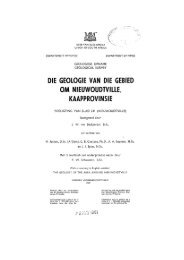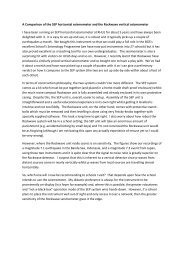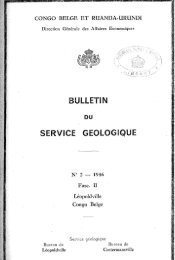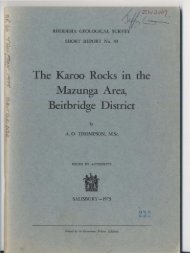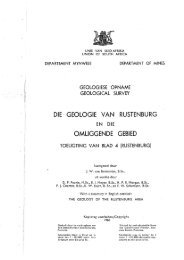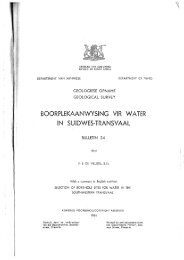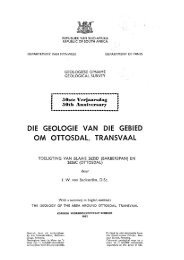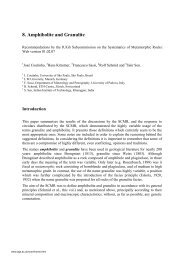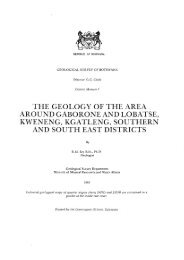Bibliography - British Geological Survey
Bibliography - British Geological Survey
Bibliography - British Geological Survey
You also want an ePaper? Increase the reach of your titles
YUMPU automatically turns print PDFs into web optimized ePapers that Google loves.
Sheail, J. 1996. From aspiration to implementation – the establishment of the first National Nature Reserves<br />
in Britain. Landscape Research, 21, 37–54. (Including the Piltdown Man Site)<br />
Sheail, J. 1998. Nature conservation in Britain – the formative years. London: HMSO, 282 pp.<br />
Shermer, M. 2001. The borderlands of science: where sense meets nonsense. New York: Oxford<br />
University Press. (Piltdown, pp. 307–319)<br />
Shipman, P. 1990. On the trail of the Piltdown fraudsters. New Scientist, 128 (6 Oct), 52‒54. (An uncritical<br />
review of Frank Spencer’s Piltdown: a Scientific Forgery and The Piltdown Papers, published in 1990)<br />
Shipman, P. 1992. Face to face with deception. New Scientist, 135 (22 Aug), 41. (Reports a cottage industry<br />
in Java involving the production of faked skulls of the Javanese Homo erectus. The author asks, ‘Will the<br />
Javan fakes provide Piltdown-like confusion? Not likely... Yet these skulls are poignant testimony to the<br />
impact of science on local communities.’)<br />
Sicher, H. 1937. Zur Phylogenese des Menschlichen Kiefergelenkes nebst Bemerkungen über den Schädelfund<br />
von Piltdown. Zeitschrift für Stomotologie, 35, 269–275. (Following a careful study of the Piltdown jaw, the<br />
author notes that the configuration of the dental foramen and its relation to the mandibular canal is completely<br />
non-human and throws doubt on the association between the jaw and skull. Cited by Weiner 1955a, 232)<br />
Sieveking, A. 1980. A new look at the Sherborne bone. Nature, 283 (21 Feb), 719–720. (A response to<br />
Farrar 1979, which the present author chose to publish in a different journal.)<br />
Sieveking, A. 1981. More on the Sherborne bone. Antiquity, 55, no. 215, 219–220.<br />
Silverberg, R. 1965. Scientists and scoundrels: a book of hoaxes. New York: Thomas Y. Crowell, 251 pp.<br />
(Including, of course, Piltdown, pp. 220–234)<br />
Simpson, G. G. 1928. A catalogue of the Mesozoic Mammalia in the <strong>Geological</strong> Department of the <strong>British</strong><br />
Museum. London: Trustees of the <strong>British</strong> Museum. (Brief description of Plagiaulax dawsoni, presented to<br />
the museum by C. Dawson, catalogue M13134, from Old Roar Quarry, near Hastings, described as ‘A single<br />
badly worn and broken molar tooth. Holotype, figd. Woodward, 1891.’ It is further stated that ‘The enamel<br />
is all worn off this crown except around the edges, and all that remains is an irregular ovate basin with a rim<br />
of varying height... The tooth is comparable only with equally worn teeth of Plagiaulax and it is probably<br />
Plagiaulacid, although its generic and specific affinities are quite indeterminable’, pp. 51–52, 192. No other<br />
examples of this species are recorded. See also Clemens 1963. In a letter to Charles Blinderman, dated 21<br />
Sept 1984 (quoted at length in Gardiner 2003, 316), Simpson states, without being specific, that Dawson had<br />
‘perpetrated a previous hoax’ prior to Piltdown. Might this be in reference to Plagiaulax dawsoni?)<br />
Smith, G. E. 1912. [Presidential address to] The <strong>British</strong> Association at Dundee: Section H. Anthropology.<br />
Nature, 90 (26 Sept), 118‒126. (Address delivered 5 Sept 1912. A discussion of man’s evolution from the<br />
early primates, in which Smith argues that the steady growth and specialisation of the brain has been the<br />
fundamental factor leading first to the development of an erect stance, and ultimately to the acquisition of<br />
the power of speech. At the time of this address, Smith was evidently unaware of the discoveries that had<br />
been made at Piltdown (e.g. Smith 1913b). He certainly became aware in about mid-November when he was<br />
asked by Woodward to report on the Piltdown endocranial cast: see Spencer 1990b, p. 35, who quotes a<br />
letter to the French neuro-anatomist, Raoul Anthony, dated 21 Nov, in which Smith writes: ‘I do not know<br />
whether you have heard that a very (pre-Heidelberg, said to be Pliocene) skull has been found in England<br />
and I want to be able to compare the brain-cast with your La Quina cast next week.’ This was written on the<br />
same day that the Manchester Guardian announced the Piltdown discovery. A more complete version of<br />
Smith’s address appeared in Report, <strong>British</strong> Association for the Advancement of Science, Dundee, 1912,<br />
575‒598, published 1913.)<br />
Smith, G. E. 1913a. Preliminary report on the cranial cast [of the skull from Piltdown.] Quarterly Journal of<br />
the <strong>Geological</strong> Society of London, 69 (1), 145–147. (Appendix to Dawson & Woodward 1913; abstract in<br />
Abstracts of the Proceedings of the <strong>Geological</strong> Society of London, no. 932, 28 Dec 1912, p. 22.)<br />
Smith, G. E. 1913b. The Piltdown skull. Nature, 92 (2 Oct), 131. (Further remarks to Smith 1913a. He notes<br />
that ‘The small and archaic brain and thick skull are undoubtedly human in character, but the mandible, in<br />
spite of the human molars it bears, is more simian than human. So far from being an impossible combination<br />
of characters, this association of human brain and simian features is precisely what I anticipated in my address<br />
to the <strong>British</strong> Association at Dundee (NATURE, September 26, 1912, p. 125), some months before I knew of



